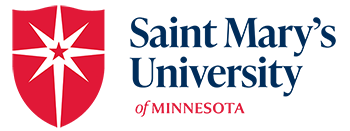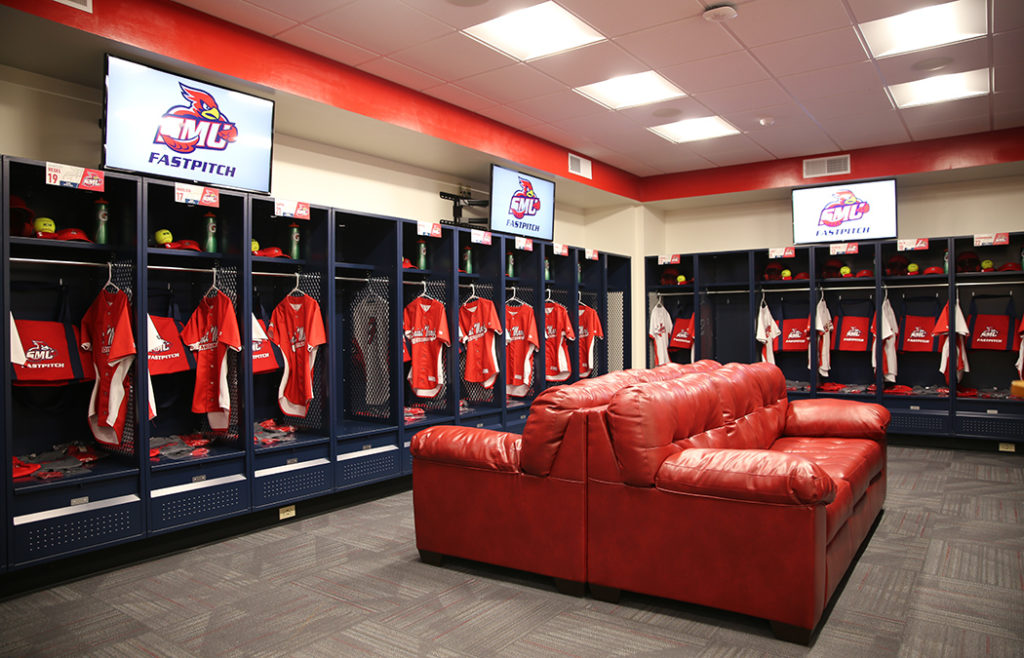Saint Mary's Newsroom / Campus Notes
Winona Campus NewsletterSaint Mary’s University announces December 2019 graduation list
WINONA, Minn. — The following Saint Mary’s University of Minnesota students completed requirements for bachelor of arts degrees in December 2019.
Carley Cronen, daughter of Michael and Debra Cronen, Kandiyohi, Minn.
Mariah D’Souza, daughter of Roger and Meggin D’Souza, Burnsville, Minn.
Samuel Eggebrecht, son of Roger and Ann Eggebrecht, Rochester, Minn.
Lily Figel, daughter of William Figel, Chicago, Ill.
Max Heukeshoven, son of Eric and Janet Heukeshoven, Winona, Minn.
Ashley Hill, daughter of Kevin and Nancy Hill, Champlin, Minn.
Trenton Jancze, son of Mark and Krystal Jancze, Woodbury, Minn.
Jack Knoblauch, son of Rainer and Cristin Knoblauch, Coon Rapids, Minn.
Nicholas Marshall, son of Thomas Marshall, Minneapolis, Minn.
Casey McCarraher, daughter of Keith and Deanne McCarraher, New Vienna, Iowa
Hailey Nisbit, daughter of Sherry Nisbit, Utica, Minn.
Mara Novakovic, daughter of Alex and Marianne Novakovic, Mokena, Ill.
Mia Ojczyk, daughter of Joe and Cindy Ojczyk, White Bear Lake, Minn.
Emily Seykora, daughter of Joseph and Ann Seykora, Eaton Rapids, Mich.
Nicholas Shelquist, son of Peter and Kelly Shelquist, Minnetonka, Minn.
Andrea Speltz, daughter of Peter and Maureen Speltz, Rollingstone, Minn.
Lillian Sterling, daughter of Ann Elliott, Minneapolis, Minn.
Cameron Taylor, daughter of Michael Taylor and Karen Terhaar, Minneapolis, Minn.
Caitlin Wallerus, daughter of Paul and Dawn Wallerus, Osseo, Minn.
Emily Wallrich, daughter of James and Jane Wallrich, Saint Paul, Minn.
Kierra Walske, daughter of Lori Walske, Rochester, Minn.
Charles Westholm, son of Fred and Rebecca Westholm, Kellogg, Minn.
Quinncy Zupko, daughter of Craig and Kerry Zupko, Wyoming, Minn.
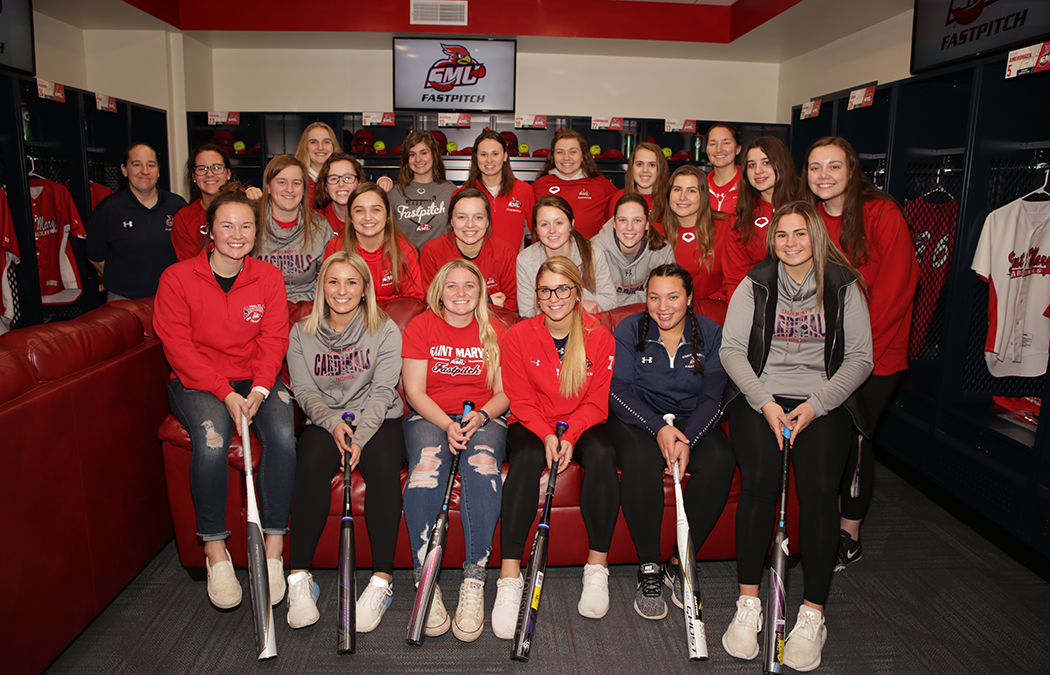
Saint Mary’s completes new women’s softball locker room facility
It was a home run in a doubleheader. Saint Mary’s University athletics unveiled and blessed a new locker room facility for Cardinal women’s fastpitch softball Monday, Jan. 20 — one year after unveiling its new clubhouse for men’s baseball.
“We know that key components of a winning team are spirit, strength, skills, teamwork, character, and the right facilities and tools,” said Tim Gossen, vice president for Student Affairs and Student Life. “This new space is just one example of how Saint Mary’s is dedicated to helping our student-athletes succeed.”
The new 1,200 square-foot space, located beneath the Saint Mary’s gymnasium, includes 29 lockers, a separate study and lounge space and team meeting space, and several large screen TVs. Additionally, private showers and bathroom facilities were constructed.
Brian Sisson, Saint Mary’s athletic director, said that all Cardinal athletic teams now have their own year-round space to call home.
“This facility is one of the spaces where we develop today’s student leaders and tomorrow’s community, business, and organizational leaders,” Sisson told the athletes at the unveiling. “We hope you use this as a space to grow — as a team, and as an individual.”
Saint Mary’s women’s fastpitch softball has played a large and continuous role in Cardinal history; 20 years ago this spring the women’s softball team brought home the national championship.
Audrey Kintzi, vice president for Advancement and Communication, thanked the benefactors who have so far stepped up to the plate to support the addition of the new facility. Six of the 29 lockers have already been sponsored.
“Our alumni tell us their time as athletes here was transformational. Here is where they made lifelong friends, where memories on the field were made, and where they learned how to time manage. Here is where they learned to both lead and be led, both of which are very valuable skills that you’ll need throughout your lifetime. It’s because of these deep and heartfelt memories that our alumni give back; they want you all to have those same experiences … and some even better ones.”
To sponsor a locker, or support women’s softball, contact Kintzi at akintzi@smumn.edu or 507-457-1486.
See more photos from the event.
Saint Mary’s Taylor Richmond Benefit to help two recipients in honor of 20th anniversary
Saint Mary’s University’s Taylor Richmond Benefit Dance, celebrating its 20th year of helping those in need, is scheduled for 8 p.m. to midnight Saturday, March 14.
For the first time, two beneficiaries will split the proceeds from this year’s event: Gianna Samountry, the younger sister of Saint Mary’s student Logan Samountry, of Richfield, Minn.; and Winonan Sue Schroetke, who has worked in the university’s Maintenance Department for the past nine years.

Gianna Samountry
Samountry, now 11, was treated with chemotherapy for neuroblastoma when she was eight months old and developed a rare autoimmune disorder called paraneoplastic syndrome. As she is paralyzed, on a ventilator, fed through a tube, and has a seizure disorder, she requires 24-hour nursing care. Samountry also has special transportation needs, and the family hopes to use their portion of the proceeds to purchase a handicapped accessible van to take her places she has never previously been able to visit.
Schroetke has battled liver disease for the past 20 years. Although last winter she received a successful transplant, she is hoping to use funding from the benefit to help her with ongoing and mounting medical bills. She also could use a dependable vehicle for her many trips to Mayo Clinic in Rochester, and help to repair the leaking roof of her home.

Sue Schroetke
The theme of the evening will be “Igniting Hope for 20 Years.” The Hall of Fame Room in the Toner Student Center will be decorated, complete with a photo booth, and refreshments will be served.
The dance, featuring music by the Johnny Holm Band, will be held in the gymnasium. Ticket prices are $15 for students, $20 for faculty and staff, and $25 for the general public and are available at smumn.universitytickets.com. Dance tickets will also be available at the door.
A silent auction will be held on campus from 9 a.m. to 3:30 p.m. Thursday and Friday, March 12-13. A variety of homemade goods, gift baskets, and specialty items will be on display in the Common Room, located on the third floor of Saint Mary’s Hall. The public is welcome to bid. Donations are needed.
The benefit has become an annual student tradition since its start in 2001 in honor of Taylor Richmond, son of former Saint Mary’s staff member Nikki Richmond. Each year, this event benefits someone in need who has ties to the university community.
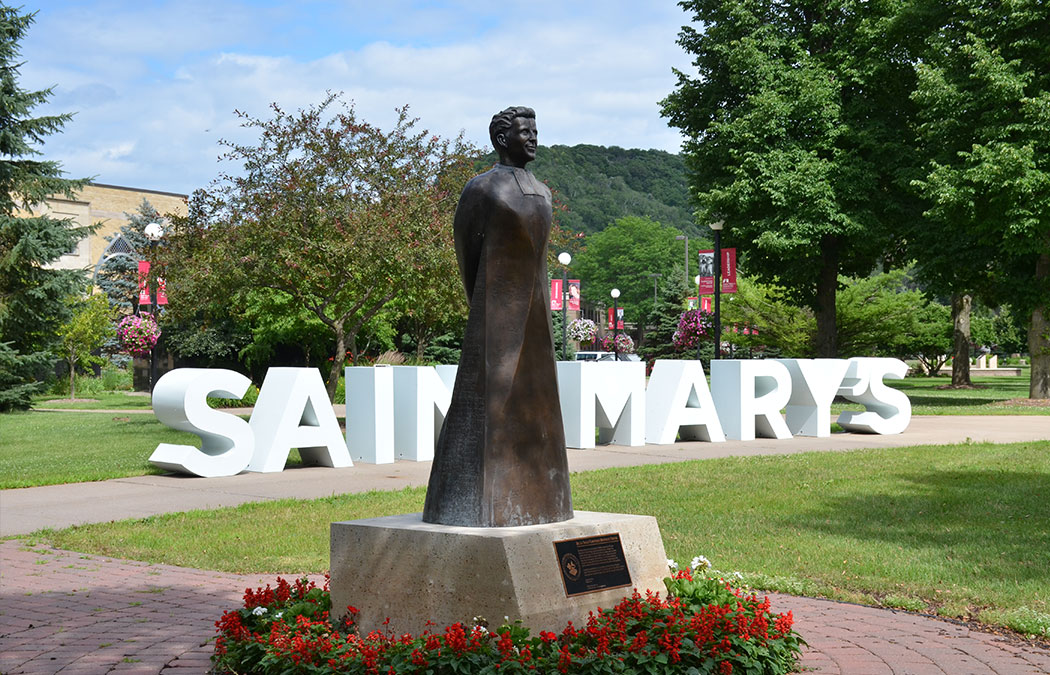
Study shows ROI of liberal arts colleges is comparable to career-focused schools
What is the value of a liberal arts education?
This question has been asked for years within circles of higher education — especially in light of an uptick in students seeking undergraduate degrees with a seemingly straight path to the job market.
Such trends have put liberal arts colleges under siege, forcing several institutions to slash or reduce programs in traditional fields and replace them with more direct job-focused majors.
According to a newly published report from Georgetown University Center on Education and the Workforce, though, the median return on investment (ROI) 40 years after enrollment from liberal arts colleges is comparable to that at four-year engineering and technology-related schools, as well as business and management schools.
The median ROI from liberal arts colleges is $918,000, more than 25% above the median ROI of all colleges and universities, which is $723,000. The median at engineering or technology schools is $917,000; business and management schools is $913,000.
For the purposes of the report, the ROI was directly determined by a dollar figure known as net present value (NPV), which was calculated through a methodology that the center developed in a previous study of ROI at more than 4,500 colleges.
The ROI at liberal arts colleges is the third highest among the 14 different types of four-year institutions, as defined by the Carnegie Classification of Institutions of Higher Learning.
Furthermore, the study found that ROI is higher for liberal arts colleges that have a high share of STEM majors (science, technology, engineering, and mathematics). Liberal arts institutions in the top third, in terms of the share of students who have STEM majors, have a 40-year ROI of $992,000. To compare, this is $179,000 more than colleges in the bottom third.

Doctoral counseling psychology student explores Hmong roots, creates large regional following with videos
‘This is something I have struggled with my whole life’
Before the keynote speaking engagements, the social media following, and the website, there was a video filmed on the cell phone of Calvin Yang M’17.
In August 2017, he had just finished one of his first classes on the Twin Cities Campus and was en route to his Doctorate in Psychology of Counseling Psychology.
The class centered on integrating culture into therapy to make it more sensitive to those intricacies, given that most of the commonly accepted therapeutic interventions were developed by white psychologists.
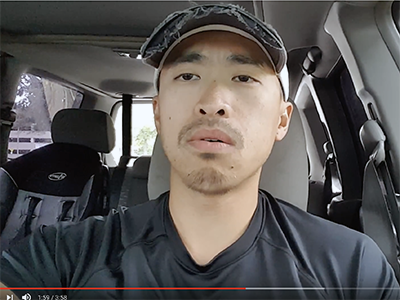
Calvin Yang’s social media following began after he took out his phone and filmed his first video in his car after one of his doctoral classes at Saint Mary’s in August 2017. The topic of his first video focused around the meaning behind a Hmong proverb that translates into English as, “Take a wrong step, and you can take that step back. Misspeak, and you won’t be able to take those words back.”
Yang, who is Hmong, immediately envisioned talking to an older Hmong individual from his community. He also thought about some of the Hmong proverbs shared with him by his family members — and how many of them were cloaked with confusion in his mind. He imagined others in the local Hmong community must have the same lack of clarity, especially within the context of trying to assimilate to modern-day life in the U.S.
“I was thinking, ‘This is something I have struggled with my whole life. And if I’m a practitioner and I don’t understand this, how am I going to be able to work with my own population?,’” said Yang, who is projected to finish his doctorate in 2021. “I thought, ‘Why don’t I share this with the people who I know in my community, so that if they’re struggling with similar issues, they can also use this to help them understand their culture and language better?’”
Yang sat down his car, hit record on his cell phone, and began talking about the first of what would become many proverbs. He posted the video to Facebook for family and friends, only to see an explosion of notifications. Immediately, his followers requested that he change the videos from private to public, so that they could share with others. They left a long line of reactions and comments.
Shortly after his Facebook account took off, Yang established a YouTube channel under the name of “dictum dose,” as another avenue to spread his videos (in December, he launched a website of the same name, which includes all of his video content and merchandise). On the wings of his videos’ popularity, Yang received an invitation to speak at an event called Culture Core at the University of Wisconsin-Eau Claire in March 2019.
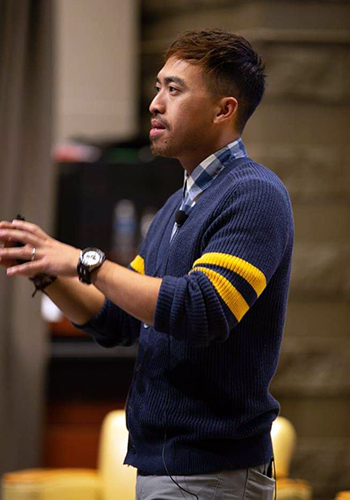
While working on his doctoral degree, Calvin Yang M’17 has done several large speaking engagements — including talks at conferences last year at St. Catherine’s University and the University of Wisconsin-Eau Claire.
Later in October, he served as the keynote speaker at the 5th Hmong Studies Consortium International Conference at St. Catherine’s University. His speech for both occasions focused on the challenges that come with navigating two different cultures, particularly as Hmong children born in the U.S. He points out that according to a 2017 study, Minnesota has the second largest Hmong community next to California. Wisconsin is third.
Although Yang had not done a lot of speeches in front of large audiences, nerves did not get to him.
“I felt comfortable because the content that I’m sharing comes from a place that I’ve wrestled with my entire life,” he said. “The things I share with people also help them find answers to the questions they’ve been having about juggling these two identities.”
When not talking at conferences, Yang can be found at local schools in the Twin Cities area talking to Hmong students about mental health issues as a committee member of a grassroots movement known as “Project Sunshine.” It formed as a means to spread awareness about mental health after a Hmong student committed suicide this past summer in Brooklyn Park, Minn. Yang said, in general, mental health has never been culturally or socially accepted by the Hmong community.
‘People are not tight’
Yang moved to Saint Paul in 1996 as a response to growing gang violence in his native Fresno, Calif. His family — including his father, mother, and six siblings — would move into a duplex shared with several of his uncles and their families, creating upwards of 20 people under one roof for about two years. Such an arrangement conjured up one famous Hmong proverb that when translated to English says: “The house is tight, but people are not tight.”
“The underlying message with that is that the house may be filled with 20, 30, 40 people, and we may be shoulder to shoulder. But we, as people, have a very open heart,” Yang says. “We’re welcoming and it never feels tight to us.”

alvin Yang M’17 and his wife, Zong (M’11), pose with their four children while wearing traditional Hmong clothing.
After graduating from the University of Minnesota with a degree in psychology, Yang wanted to pursue the field in greater depth, but those plans were halted after he and his wife married and began having children. They have two boys and two girls. “She was actually my very first best friend,” Yang said of his wife, whom he met in sixth grade at Hazel Park Academy in Saint Paul.
To provide for his family, Yang took a job as an insurance adjudicator, a position he held for five years. In that job, part of his responsibilities was working on mental health-related claims, allowing him to see firsthand the issues that he had studied as an undergraduate.
His wife, Zong, having earned a M.A. in Human Resource Management at Saint Mary’s in 2011, encouraged him to check out the M.A. in Counseling and Psychological Services program.
“I looked at Saint Mary’s and it was affordable and it was very flexible,” Yang said of starting the master’s program in 2014. “It was catered toward young, working adults. And so I thought, ‘Hey, why not? If I can do this and still be a parent, I’ll do it.’”
A seminal moment
The decision to pursue his Psy.D. was solidified in large part by one conversation that he had in 2016 with his oldest child, who was in kindergarten at the time: A fellow student told her that she could not play with them on that day “because brown people can’t play with us.” His daughter wanted to know what that meant.
“I wasn’t sure how to explain it to her,” Yang said. “So of course, I just told her, ‘Kids will be kids, and they just don’t want to play with you and that’s OK. No big deal.’ But inside something was boiling up like, ‘What does this mean to me? What am I going to do about this?’”
Yang realized that he did not possess the language to articulate what he wanted to say to his daughter in a way that both she could completely understand and that would satisfy him.
“I think the program at Saint Mary’s really gave me that language. I think the biggest piece I learned was to be OK with feeling upset that I was discriminated against. I’m able to have a voice.”
— Calvin Yang
“I think the program at Saint Mary’s really gave me that language,” Yang said, by helping him step outside of his comfort zone and develop greater self-awareness and understanding. He points in particular to conversations he has had at the monthly university-affiliated Student of Color Consultation meetings held at the Twin Cities Campus.
“I think the biggest piece I learned was to be OK with feeling upset that I was discriminated against. Before, I’d think, ‘OK, it’s not a big deal. Move on,’ but now, it’s ‘No, that’s not OK. And what happened there is also not OK.’ I’m able to have a voice,” Yang said when reflecting upon his own experiences that he had swept under the rug, so to speak, while growing up.
“I think the faculty of Saint Mary’s has helped me to understand more about the impact that I have on my kids and how my culture in itself impacts my life overall.”
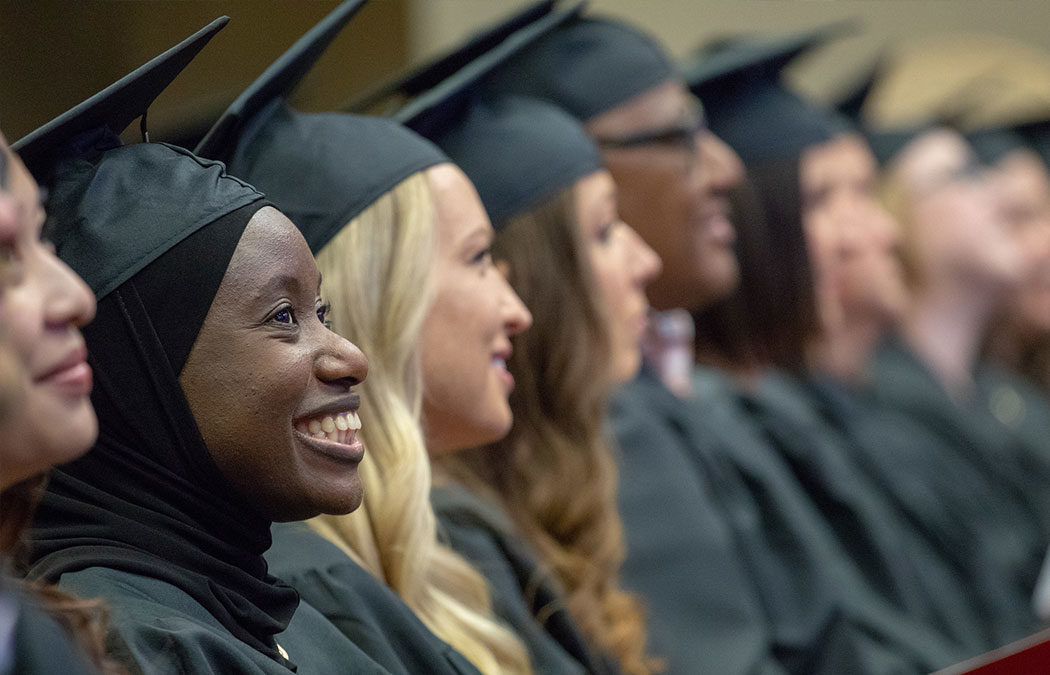
Adult learners to graduate Jan. 25 on Saint Mary’s Twin Cities Campus
MINNEAPOLIS, Minn. — More than 370 adult learners will graduate from Saint Mary’s University of Minnesota and its Schools of Graduate and Professional Programs on Saturday, Jan. 25, where two commencement convocations will honor the graduates.
The ceremonies, to be held at 10 a.m. and 12:30 p.m. at the Saint Mary’s University Center on Park Avenue in Minneapolis, will feature four graduates who have been invited to provide reflections as part of the ceremonies. Another five graduating students will be honored with awards.
Graduating students providing reflections are:
- Isse Abdi, B.S. in Information Technology
- Justin David Bloch, B.S. in Business Administration
- Jim Lee, M.A. in Educational Leadership
- Diana-Christine Teodorescu, Ed.D. in Leadership
Graduating students being honored with Outstanding Final Paper Awards are:
- DeVonne Rita Ollila-Sheak, B.S. in Marketing
- Shruti Jalota, M.A. in Management
- Nicolle Marie Venneman-Bauer, M.A. in English as a Second Language
- Amanda Mae Shultz, M.A. in Special Education
Graduating student being honored with Outstanding Dissertation Award is:
- Abdiqani Farah, Ed.D. in Leadership
Saint Mary’s Twin Cities Campus, Apple Valley location to close from 5 p.m. Friday through Saturday
Due to weather conditions, Saint Mary’s University’s Twin Cities Campus and Apple Valley location will close, beginning at 5 p.m. today, Friday, Jan. 17, and will remain closed Saturday, Jan. 18. No classes will be held in these two locations during this time, and offices will also be closed.
Three Doctoral Chevrons
There is a narrative from medieval times that describes the nature of the three chevrons on the sleeve of a doctoral robe. As legend has it, those three stripes stand for the three pillars of doctoral scholarship: academic curiosity, academic honesty, and academic courage. Whether or not this tale came from the hallowed halls of Oxford or not doesn’t really matter; what does matter is how we as scholars today support these pillars.
Academic curiosity means our minds are open, probing, and dynamically asking questions and seeking new perspectives of understanding. We show this in class by forming community, respecting the opinions of others, and engaging in critical dialogue without criticizing the character or humanity of another. We show this in our research through a disciplined and open approach, through a dedication to scholarly writing, and through a willingness to put theory to practice.
Academic honesty means a significant and holistic commitment to scholarship. We show this through our deep commitment to the rigorous coursework, comprehensive examination, and dissertation process. Being in attendance, with your whole self, not only benefits your scholarship, but the development of all those in your learning community. This is also shown through a significant attention to the practice of scholarship, both in the written and oral traditions. The integrity of your word — written, spoken, and practiced — is paramount.
Academic courage is displayed through the intention, attention, and dedication to ask hard questions, to work the data as it is, to report reality as it is experienced. We show this in class by not avoiding uncomfortable academic topics, or difficult conversations. As a Lasallian community of scholars and faculty, we care for the holistic development of all those in our cohort, and to the best of our ability we encourage and support their academic success.
By: Matthew Nowakowski, MBA, Ed.D., program director and core associate professor
The Value of Collaboration
There are many things that cannot be taught, and others that cannot be learned. Creativity, raw talent, ideation, and stakeholder theory are all problematic. Being in the DBA program requires a significant amount of time spent learning — venturing on an endless path of curiosity.
That said, it is not prudent to exclusively learn in isolation. Collaborating, cooperating, co-authoring, research teams, and writing partnerships should be part of your aspirations to support intellectual inquiry and cognitive development while at Saint Mary’s University of Minnesota… and beyond. This will help activate your creativity, talent, and ideation, and become intellectually awake.
I encourage you to take advantage of opportunities to work with members of your cohort, and faculty, and become active in management academic and practitioner professional organizations. Attend conferences. Conferences provide you with the opportunity to engage with other scholars, disseminate your work, think creatively about your learning, and have some fun with like-minded, like-experienced academics.
If you have questions about how to find conferences, develop writing proposals, or present your work, please don’t hesitate to contact me (or other DBA faculty members).
In creative, talented, idea association, Jennifer L. Schultz, PhD. jlschult@smumn.edu
By: Jennifer Schultz, Ph.D., core associate professor
A Transformational Experience
As you journey through this DBA learning experience, it is my hope that you are prepared for a transformational experience. The DBA experience is designed to be different from other educational experiences. It is more integrated and holistic in perspective. You can certainly ease your way through the program. However, if you challenge yourself cognitively and emotionally, your capacities will be stretched and strengthened.
The DBA experience should expose you to opportunities that change the way in which you see and interact with the world. For some, this may seem threatening. For others, it may seem too lofty, and for others this is why you enrolled in the program.
Earning a DBA is serious business. Maximum value can only be achieved when you commit the time and effort needed to fully leverage what is being asked of you. Hopefully, the whole experience will be transformative. If it wasn’t, then there is no valid reason for undertaking the experience. Since transformation is the goal, so it is prudent to clearly identify the goals to be attained.
After you have completed the program, how will you be different? Will you have to tell people you have obtained a DBA or will they know it through your insight and contribution? For example, a caterpillar doesn’t have to tell anyone it has become a butterfly. Similarly with you, people should see the difference. You need to set audacious goals. Accompanying these goals should be a plan for execution.
Some of these goals could include:
- heightened self awareness
- increased emotional intelligence/resilience
- strengthened level of confidence
- tolerance for ambiguity
- improved learning agility
- enhanced technical skills
- widened peer networks
A helpful way in seeing yourself differently is to think of yourself as a brand. Generally, we associate brands with corporations such as Nike, Starbucks, Apple, Southwest Airlines, etc. Over the years these brands have become powerful and they resonate emotionally with many people. The reason for the resonation is brands are relationships. There is an emotional connection. Brands stand for something. Brands are promises. Brands are distinctive. Brands are perceptions. Brands are relevant and they consistently deliver on their promise. Strong brands make a difference. The strength of a brand impacts the difference it is going to make. Companies that have a strong brand have a mission, vision, and values that are shared by associates and clients. Strong brands are game changers.
The concepts of being a brand and making a difference have been adopted by many individuals who have branded themselves. Strong individual brands that quickly surface are George Foreman, Tiger Woods, Kylie Jenner, Kim Kardashian, Will Smith, Rihanna, Julia Roberts, David Beckham, and Oprah Winfrey. Over the years, these individuals spent time developing their brands. They also know how to leverage their brands. Recently, Kylie sold part of her brand name company for over $600 million.
As you begin your transformational experience, I encourage you to craft your life’s mission, vision, and values. By developing these, you create the possibility of greatness. As you strengthen these, they will resonate with others and increase your effectiveness.
Brands are about making a difference. The question is, “Are you prepared to make a difference?”
Reference Books
The Art of Possibility: Transforming Professional and Personal Life by Rosamund Stone Zander, and Benjamin Zander
Free Agent Nation: The Future of Working for Yourself by Daniel H. Pink
The Brand You 50: Or: Fifty Ways to Transform Yourself from an ‘Employee’ into a Brand That Shouts Distinction, Commitment, and Passion! by Tom Peters
The Brand Called You. Forget about Your resume. You don’t have a Resume. You’ve got a Marketing Brochure for the Brand Called You. Fast Company. by Tom Peters.
Be Your Own Brand: A Breakthrough Formula for Standing Out from the Crowd by David McNally and Karl Speak
Build Your Own Life Brand! : A Powerful Strategy to Maximize Your Potential and Enhance Your Value for Ultimate Achievement by Stedman Graham
Make a Name for Yourself: Eight Steps Every Woman Needs to Create a Personal Brand Strategy for Success by Robin Fisher Roffer
The Product Is You!: Position Yourself for Success as an Advisor by Mark Magnacca
By: Brian (Raj) Beekie, M.A., Ed.D., core associate professor
Virtue in the DBA and Beyond
From a Lasallian perspective, the underpinnings of virtues permeate the Saint Mary’s culture. For example, new faculty are introduced to the concept of the 12 teaching virtues. From an organizational perspective, we ensure that the five core Lasallian virtues are imbued throughout our culture. Specifically as it pertains to our university, the mission stresses the importance of awakening, nurturing, and empowering learners to ethical lives of service and leadership. Thus, the concept of virtues are imbued throughout ethos of the university. The remaining paragraphs will provide a brief overview of virtues and introduce the idea of a meta-virtue.
Given virtues are at the substrate of the ethos of the university, it is important to provide some context as to the genesis of virtues and what exactly they are. The etymology comes from the Latin word – virtus, which translates to strength. Hence, virtues provide individuals with opportunities to strengthen their character. For example, when someone exhibits the virtue of generosity, that person is typically viewed in a positive light. On the contrary, the opposite of virtues are vices. For instance, when someone is deemed to be selfish, we normally associate such behavior negatively. This is why virtues are correlated with positive characteristics and are also called character strengths in some academic fields, particularly, in the study of education.
The field of education and positive psychology has aided our understanding of virtues. Historically, virtues were codified and examined in a moral context. For example, when we explore the virtues of compassion, fairness, and gratitude, the foundation of such conversations are normally associated with our humanity. However, the construct of virtues is currently examined and researched from a more panoptic and robust framework. This topology is separated into four sub components. The first category and the oldest is moral, as discussed above. The second category — is civic such as volunteerism or community engagement. Third are intellectual virtues such as critical thinking and curiosity. Last, but not least, are performance virtues: grit, resilience, and emotional intelligence.
The study of virtues dates back to antiquity, and, a number of Greek philosophers are credited for introducing the study to the Western Word, Aristotle, in particular. What is interesting about Aristotle is that he generally focused on the moral virtues, but he believed there is a meta-virtue and it serves to bridge all the other virtues. He called this meta-virtue phronesis, which means practical wisdom. Aristotle purported that phronesis is the glue that held all other virtues in place and provided the nutrients that afforded individuals the ability to leverage all other virtues in a meaningful way in order to flourish as a society. This is why he would espouse that individuals should be compassionate toward the right person to the correct degree at the appropriate time. Thus, exhibiting compassion in and of its self is not enough; we must wield various virtues in a more sagacious manner.
By: Antar Salim, MBA, DBA, core associate professor

Recent graduate returns to Minnesota to take part in race, recruit for Lasallian Volunteers
EDITOR’S NOTE: This story was published in January before the COVID-19 pandemic hit America — in particular New York City, where Aldontae Guess ’19 has been serving as a Lasallian Volunteer at a high school in Brooklyn since the beginning of the school year. We recently reached out to him and are happy to report that he is doing well. He is establishing virtual prayer services for the high school community through platforms such as Facebook Live and Zoom. “It’s certainly a different shift on things,” Guess said. “We’re trying to adjust the best way we can and just do what we can.” Although his neighborhood is a lot quieter than it usually is, he said there are signs of life, togetherness, and resilience like the nightly 7 p.m. ritual of making noise to honor health care workers. “Even sometimes just a small gesture can have the biggest impact on people,” Guess said, “something as simple as just telling someone ‘Thank you.’”
If you ask him, Aldontae Guess ’19 will tell you that he’s a city guy at his core, having been raised on the West Side of Chicago.
So when it came to living and serving in New York City as part of the Lasallian Volunteers program, the transition was pretty smooth.
“I’m used to the car horns and people and everything else,” he said.
Guess has called the much smaller town of Winona home for portions of the year, beginning in 2011 — first as a recently graduated eighth-grader taking part in the Countdown to College summer college preparation program at Saint Mary’s University of Minnesota and later as a Saint Mary’s First Generation Initiative (FGI) student. He is one of 137 graduates of Countdown to College and one of about 50 graduates of FGI since the programs formed in 2010.
In late October, Guess made his first trip back to Minnesota since graduating with his B.A. in Psychology in May to take part in the 14th annual “LVs Run,” in which volunteers raise money for their organization by having patrons sponsor their participation in a race. The goal this year was to raise $65,000.
The featured race for the fundraiser changes locales every year. As luck would have it, this year’s event took place around the Minneapolis Halloween Half Marathon on Oct. 26. Along with his fellow volunteers, Guess took part in the 5K portion of the event — raising more than $3,000 in pledges, placing him as the second-most sponsored runner.
“I pushed through, but I was glad to be done,” said Guess, who had members from the Saint Mary’s community cheering him on throughout the race.
Visiting old friends
Following his time in Minneapolis, Guess headed to Winona to meet up with professors, staff, students, and others he had formed relationships with through various student activities and affiliations, including the Student Activities Committee, the FGI office, and Serving Others United in Love (S.O.U.L) Council. Last spring, he was presented with the Student Service Award.
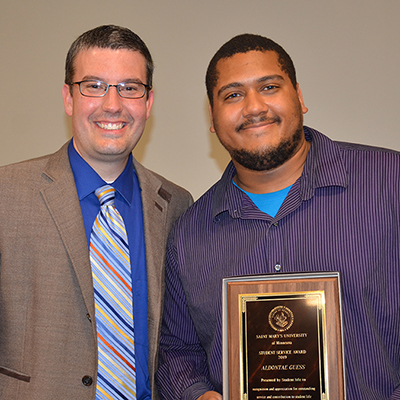
Tim Gossen, vice president for Student Affairs and Student Life, presents Aldontae Guess ’19 with the 2019 Student Service Award.
“Aldontae earned the nickname of ‘The Mayor’ of campus while he was a student,” said Alisa Macksey, dean of Student Success and FGI. “Aldontae was the student who always said hello to everyone and went out of his way to make everyone in the community and visitors feel welcome.”
Besides catching up with familiar faces, Guess joined with other Saint Mary’s alumni who are serving as Lasallian Volunteers in giving presentations on the Winona Campus. Their hope was to spark interest with students who may also be interested serving others by becoming a Lasallian Volunteer, a program celebrating its 30th anniversary this year.
Guess is serving as a volunteer at Bishop Loughlin Memorial High School in Brooklyn, an assignment that will last until the end of the school year. He is one of two first-year volunteers who are graduates of Saint Mary’s, the other being Jessica Bauer ’19 at the De La Salle Blackfeet School in Browning, Mont. In addition, there are four second-year volunteers who graduated from Saint Mary’s: Sheyenne Bauer ’18, San Miguel School, Chicago; Regina Bettag ’18 , De La Salle Blackfeet School, Browning, Mont.; Chris Lackey ’18 La Salle School, Albany, N.Y.; and Benjamin Peters ’18, Cristo Rey De La Salle High School, Oakland, Calif.
Guess felt a call to serve since his sophomore year when he went he co-lead a S.O.U.L. (Serving Others United in Love) immersion trip to the San Miguel School of Tulsa, Okla., during spring break of 2016, when he and his fellow volunteers helped supervise the school’s students, as well as helped with homework and provided afterschool assistance.

While in Minnesota last October, Aldontae Guess ’19 gave a presentation to Saint Mary’s undergraduate students about the Lasallian Volunteers program. The priority consideration deadline is Saturday, Feb. 15.
Guess said this trip was one of his primary reasons for applying to the program. “It was really being with the Christian Brothers and the volunteers, spending that week, and really seeing De La Salle’s mission being done right before my very eyes that inspired me to continue serving,” Guess said.
‘The sense of community’
In his role at the Brooklyn high school, Guess’ official title is a volunteer for student life. His responsibilities include assisting with Mass, prayer services, retreats, and social events that take place during school hours. In addition, Guess also assists with day-to-day operations in the school’s library, development office, and campus ministry office.
Given his experiences thus far, Guess would like to come back for a second year of volunteering at Bishop Loughlin before applying for graduate school for a to-be-determined area of study.
Of course, he welcomes fellow Saint Mary’s alumni to join him in the program, which has a priority deadline of Saturday, Feb. 15.
What does he think is the organization’s biggest selling points?
“Just the network that you’re a part of,” he said. “I think the sense of community you get from it — and the chance to be of service.”
Featured image: Aldontae Guess ’19 strikes a pose after finishing the 5K race at the Minneapolis Halloween Half Marathon in October.

Franke completes summer internship at clinic in Spain
Experience a perfect fit for biology, Spanish double major
Senior Danielle Franke was able to uniquely blend her biology and Spanish majors through an eight-week internship in Spain last summer. At the Centro Medico Estación, Franke received an invaluable clinical experience before she prepares to apply to medical school. It also allowed her to have a fully immersive experience as the only staff person who was a native English speaker.
Throughout her time at Saint Mary’s University of Minnesota, the Mounds View, Minn., native looked for the right study abroad opportunity to best suit her double majors in biology and Spanish. Heading into her senior year, she found it.
“It was a really good way to blend two interests together,” Franke said. “I was able to learn about the medical system in Spanish, which I don’t know how I’d be able to do any other way.”
A new level of translations
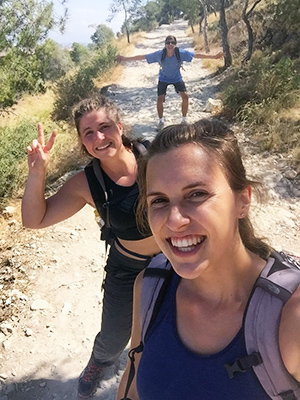
Senior Danielle Franke, center, hikes up Mount Benacantil with friends from the study abroad program she took part in last summer.
Franke fully embraced the atmosphere at the private clinic, located in the coastal town of Alicante, Spain. At times, she would translate for both doctors and patients. One of the biggest challenges was learning the words in Spanish for various types of medical terminology and equipment, which had never been covered in any Spanish classes she had taken in the U.S.
“Half of the Spanish language cannot be taught in the classroom, and you have to just learn by talking to people and making mistakes, which I did all the time,” Franke said. To help improve her conversational abilities, Franke enrolled in a class called “Spanish in the Working Environment” at the University of Alicante.
Two days each week, Franke worked in the clinic’s laboratory, where she collaborated with doctors and technicians to analyze blood and urine samples. On the other three days, she would observe and administer patient tests, such as lactose, sucrose, and fructose tolerance tests.
Approximately 30 specialists would come into the clinic during the course of the week. In addition to her regular responsibilities, Franke was also able to sit in on some of those specialist appointments. This included time with the staff gynecologist — an opportunity she appreciated, given that she hopes to focus in obstetrics in medical school. She also had the opportunity to scrub in at the nearby public hospital and observe cancerous portions of a larynx being removed from a patient.
Several steps
Franke initially learned of the internship opportunity from her Spanish adviser John Reed, Ph.D., associate professor of English and World Languages. Dr. Reed knew that several Saint Mary’s students had had successful study abroad experiences in Spain and Latin America over the years through Spanish Studies Abroad.
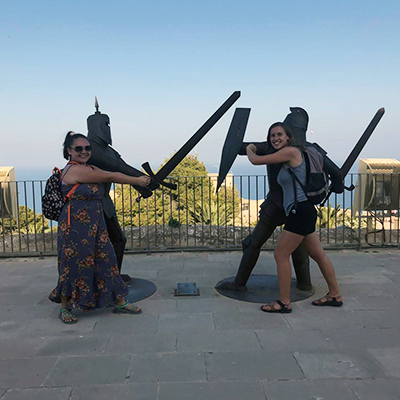
Senior Danielle Franke, right, poses with a friend on the top of Alicante’s famed Castillo de Santa Barbara.
Given the rare opportunity to work in a medical clinic as a study abroad student, the application process to the program involved completing several materials, including a cover letter, résumé, and interview in Spanish. In addition to gaining approval by the organization running the program, she also had to get the green light directly from the clinic.
To allow for some tourism time, Franke arrived in Madrid six days before her internship began. She also tacked on more time after its conclusion to visit other Spanish cities. Out of all the places she traveled to, the cobblestone-street charm of Granada was her favorite. Still, she very much enjoyed her time in Alicante. Her most memorable activities included taking in the views from the top of the Santa Barbara Castle, which towers above the city on Mount Benacantil, and dining on the potato omelet concoctions that her host would make (known in Spain as “tortilla de patatas”).
“It’s a very Mediterranean beach town in lots of ways, but it has few of the traditional aspects of Spain. It’s different than the rest of Spain I traveled to,” Franke said. “Alicante has a specific vibe because it’s close to the beach and more laid back.”
Franke, who is also a member of Saint Mary’s cross country and track and field teams, is currently preparing to take the Medical College Admission Test (MCAT) in January as she prepares to apply to medical schools in June.
As her career progresses, she hopes to continue to use her Spanish skills when working with bilingual patients in the U.S. to make the medical system more accessible.
Featured image: Senior Danielle Franke with co-workers in the laboratory at Centro Medico Estación in Alicante, Spain. Franke became the clinic’s third intern in its history.
